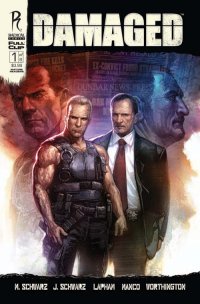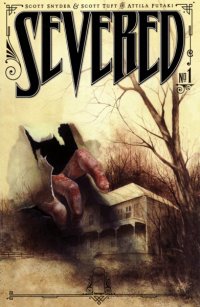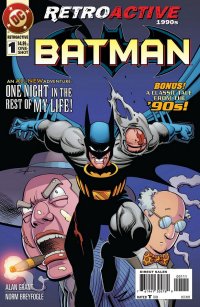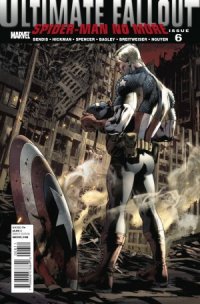Damaged #1 (Radical Comics, $3.99)
By Adam Prosser
American pop culture is in love with the concept of vigilantism. It’s kind of hard to deny it. From pulp noir to westerns to martial arts stories to, of course, the superhero genre, the idea of a lone hero operating outside the law for the sake of higher justice—usually killing arenas full of bad guys along the way—occurs over and over and over again in movies, TV, books, and comics, and it’s rare indeed to find an example of the form where it’s portrayed as being purely, or even mostly, a bad thing. Even a real-world incident like the recent death of Osama Bin Laden, which absolutely played out according to badass action revenge movie rules instead of the much less sexy international laws of engagement and conflict, is seen as filling a need in our collective psyche. We respond instinctively to the idea of a dark hero, or group of heroes, who can take out our anger at the state of the world by proxy. And at the risk of sounding like I’m coming down with premature old-man syndrome, with our pop culture currently stuck in full pander mode, something that strikes such a deep chord in us is less and less likely to be portrayed as anything but positive.
Interestingly enough, the superhero genre is the one that’s probably taken the hardest, most disapproving look at the idea of an unaccountable badass using brute force to clean up the streets, despite supposedly being a pure fantasy. Meanwhile, “realistic” noirish crime stories seem all too happy to take the simplistic world view and run with it, serving up a full-course meal of criminal scum to be flambed by some tortured but righteous avenger. It’s an almost inevitable by-product of the noir genre, which basically starts from the most blackly cynical attitudes about institutions and human civilization; when that’s your starting point, it’s all too easy to slip into siding with the vigilante mindset.
Fortunately, Damaged seems like it’s going to take a more nuanced look at these themes, even as it serves up a heapin’ helpin’ of the brutal, bloody action we all plunked down $3.99 to read about. In fact, the opening sequence of this first issue (“Executive produced” by Sam Worthington—yeah, the guy from Avatar—and created by Michael and John Schwarz, but written by David “Stray Bullets” Lapham, and no, I haven’t been able to find out why the “creators” of the book didn’t actually write it) gives us a vigilante character who’s one skull shirt away from being The Punisher. He walks into a bar and identifies a quartet of rapists whose guilt can’t be legally proven, then proceeds to mow down these worthies but also the people who nodded assent when they gave their half-assed alibi. “That makes you an accessory”, growls Not-Frank-Castle before torching the establishment with everyone in it. Four weeks later, we pick up in San Francisco, where a young police lieutenant, Jack Cassidy, is about to be handed his dream job on the special task force of organized crime—over the metaphorical body of Cassidy’s hero, Captain Lincoln, who’s being “retired” due to some embarrassing incidence involving acts of vigilantism among his men. But Lincoln still believes in the law and due process, a faith that’s seemingly due to be tested when our cod-Punisher arrives in town, and reveals a surprising connection to Lincoln.
To anyone raised on a diet of Frank Miller comics, I suppose it’s possible to view the acts of Damages’ Lone Gunman—his name is Henry—as simple revenge fantasy, and it’s possible that I’m misreading it in that regard. After all, this is a comic published by a newly created imprint and overseen by a bunch of Hollywood people—which almost certainly means it’s being generated as a possible movie project, and as I said, Hollywood loves its simplistic revenge fantasies. Yet it’s pretty clear to me that Lapham is setting the stage for something a lot more morally complex; Henry is clearly out of control, killing relatively regular people for pretty dubious reasons, for all that we’re conditioned to root for characters like this. Furthermore, Lincoln’s own relationship to vigilantism—he’s not guilty of it himself, but he may have condoned it or at least allowed it to fester—seems to indicate someone who’s aware of the moral cost it entails.
It’s possible that Damaged will revert to yet another story where the protagonist strides in slo-mo through a hail of bullets to execute deserving bad guys while the audience cheers. But as the title seems to indicate, I think Lapham’s aware that a vigilante is just as likely to be a troubled, impotent person who creates just as many problems as he solves.
Rating: 




Out of a Possible 5 Stars
 Severed #1 (Image Comics, $2.99)
Severed #1 (Image Comics, $2.99)
By Graig Kent
“Behind these pearly whites, I got razor sharp teeth.”
So explains Mr. Porter, a tall, lean, weathered, mustachioed man, having just recruited young Freddie from an orphanage in 1916 Illinois under the guise of giving him an apprenticeship with General Electric. But there’s probably no apprenticeship,and probably nothing good in Freddie’s future, as he discovers while practicing some wiring in an abandoned farmhouse that Mr. Porter wasn’t kidding about those teeth.
But Freddie isn’t the protagonist of the book. That role belongs to Jack Garrison. In a prologue set in a more modern day (relatively speaking) Jack, aged and settled, and sans his right arm which he tells people he lost in the war, receives a letter that shakes him deeply, thrusting him back into his memories. Memories of violin practice, of a loving mother, of running away, of riding the rails and of the rapidly cascading harsh realities he discovers along the way.
Upon first reading this book from co-writers Scott Snyder (American Vampire, Detective Comics) and Scott Tuft, I was less than enthused. “Yeah,” I said to no one in particular, “so Jack gets his arm eaten, what of it?” Perhaps I was tired and just not paying close enough attention because it’s rare that I forget that it’s not always about what happened, but how and why, the journey getting there. In rereading it, I’m invested in the set-up far more, and realized I had completely misread the conversation between Jack and his mother about his plans to “hobo around for a while” and his mother’s surprise of prep-school acceptance. Rather than running away to escape unbearable oppression, as is the cliche, Jack runs away to chase a strangely glorified lifestyle. I guess hobo-ing around was the 1910’s version of backpacking across Europe?
Severed isn’t a straight up horror of today’s expected sort with massive teenage deaths, but instead a moody creeper. It’s not about scaring you, but building an atmosphere and making you feel unsettled just a little bit. It’s the kind of horror that’s gotten lost, replaced by jumps and startles, gore and gags. The writers Scott build their mood nicely, though I found the jumping between the prologue and the stories of Jack and Freddie to be a little puzzling at first read. This is a book you need to take a bit of time with and let it seep in.
Thankfully, joining the writers Scott is artist Attila Futari whose attention to detail leaves a lot of opportunity for the eye to wander around the page. Futari’s work is very natural and European in sensibility, giving both the 1910’s and the 1950’s prologue a tangible setting that his characters don’t just inhabit but live and breathe in. The earthen color palette Futari works with estalishes a crisp fall atmosphere that leaves the book with a damp bite turning to a full-on chill with an early snowfall. That mood the writers Scott build with their story is perfectly complimented in the art.
Rating: 




Out of a Possible 5 Stars
DC Retroactive 1990’s Batman one-shot (DC Comics, $4.99)
by Graig Kent
Alan Grant served on a, roughly, 10-year tour of duty with Batman, working alternately on Batman and Detective Comics from 1988 through to 1992 and from then through to 1998 on Batman: Shadow of the Bat (plus dozens of specials and mini-series over the years). During that time he created a number of prominent members of Batman’s Rogues Gallery, including Mr. Zsasz, Anarky, and the Ventriloquist. Along much of that journey Grant was paired with artist Norm Breyfogle, the team acting as a stable presence amidst plenty of chaos dished out on the Dark Knight over that time frame. Their time together created a tremendous run of one-and-done issues, as well as some damn fine multi-part stories, like the four-issue “The Mud Pack” exploring the Clayface legacy, and “The Last Arkham” which penetrated the famous Asylum and it’s history like never before. If there was ever a Batman creative team that should be called “the dynamic duo”, it’s Grant and Breyfogle.
As you can guess, people of a certain age have a rather profound fondness for this creative team. At a cursory glance, one might not see what the big deal is with fairly standard comic book storytelling and an unconventional illustration style, but the years of work these men did together can’t be summarized by one or two issues. Unfortunately that’s all you get here with the DC Retroactive 1990’s Batman one-shot, two issues, one brand new, and one reprint sandwiched together in a less than celebratory package. The new story finds Grant and Breyfogle teaming once more on their creation, the Ventriloquist, and his dummy Scarface (or is it the other way around), just freed from jail, pending trial, and throwing a party. Batman, taking care of business as usual on the streets of Gotham, is keeping an eye on things just in case they get out of hand. And of course they do, as a discarded mobster get’s toxic goo’d back to superpowered life and is out for revenge. Then there’s a bizarre c-plot about a cab driver that ties all three strings together in a messy, uncertain knot.
Let’s just say this is not Grant’s finest work. He’s been out of touch with the Bat for a while now, and this story is less a Batman story than an attempt at executing a clever serendipity story. To Grant’s credit, he is as in touch with the voice for Scarface and Alfred as he always was, but the dialogue elsewhere just seems as cartoonishly overblown as the plot. The back-up feature (as has been the case with many of the Retroactive books) is an odd selection, and not the finest example of Grant’s long history of work. This one gets a bit too heavy handed, striving for a moralistic tale about garbage amidst a turf war among garbage collectors, yet, looking at a book from 1990 about our problem with excessive refuse in a pre-recycling era, one can appreciate the foresight involved and Grant’s attempt to raise awareness via the medium of superhero comics.
Breyfogle, for his part, is in surprisingly good form for the new story. His work has tightened over the years, with fewer lines, and a lot more of a softer edge. There’s more of a cartoonist sensibility to his work today, a lighter touch with the blacks as well, which all may not be as “Batman” as it used to be but I should say it’s still distinctly Breyfogle The coloring here is unfortunately quite muddy, and a modern colorset doesn’t seem to compliment as well as the old four-color world. as witnessed in the back-up. It’s true that Breyfogle’s a unique talent, and that his style is one that many Bat-fans actively disliked, but for all his eccentric lines, there’s the dynamic and inventive storytelling to counter-balance. The back-up feature, for any of its story weaknesses, has some solid examples of what made Breyfogle such an essential Bat-artist, starting with his dramatic title page, through to his use of the shadows in Batman’s cape (few artists use Batman’s cape to such effectiveness), and his exciting sense of movement, whether it’s a fight sequence or Batman swinging through town.
On the one hand, it’s absolutely lovely seeing the Grant/Breyfogle team back in action, but it’s such as shame that it doesn’t quite measure up to the legacy that they’re known for. And yet, I would happily pay to see more.
Rating: 




Out of a Possible 5 Stars
 Ultimate Fallout #6 of 6
Ultimate Fallout #6 of 6
(Marvel, $3.99)
By Jeb D.
The comic mini-series with the blandest title in history wraps up this week pretty much the same as it’s gone on for the previous five issues: herky-jerky stop-and-start storytelling, with a crazy quilt mixture of characters and creative teams. Which doesn’t make it bad by definition; it does mean, though, that it helps to be in the mood for a sort of low-key roller coaster ride.
Following on from, and mingled with, the events resulting from the death of the Ultimate version of Peter Parker, the short stories in this series have dealt with the “fallout” of that tragedy (and of the Ultimatum thingie that came before) on the rapidly-diminishing cast of familiar characters in the Ultimate U.
The first story is a deck-clearing exercise as Brian Bendis and Mark Bagley (with Andy Lanning on inks and Paul Mounts coloring) continue their reunion on the Ultimate Spider-Man cast, with Aunt May and Gwen Stacy deciding how-and if-they want to get away from New York, and memories of all they’ve been through. Not a lot to it (beyond the decision they reach), but anyone comfortable with Bendis’ approach to dialog will enjoy the easy rhythms and natural flow to the encounter. Nick Spencer and Eric Nguyen then follow Kitty Pryde as she leads Bobby Drake and Johnny Storm (amazing how those names still evoke Stan and the Swingin’ 60’s) into a “new” home and refuge, and if the big reveal impresses the reader less than it does Bobby and Johnny, the brief segment reinforces Spencer’s expert handling of these young teens (Marvel, get this guy on a new Runaways series now!). Jonathan Hickman and Mitch Breitweiser up the stakes against Nick Fury as he finds out that the Ultimate U has lost yet another key figure when Captain America bails, and then Bendis and Bagley bring things full circle as Fury confronts both Mary Jane Watson, and his own guilt. While none of these stories have the same gutpunch as last issue’s deliciously ominous Quicksilver outing, they’re mostly effective in their own ways, leaving some strong visual impressions behind (Aunt May sleeping with Peter’s costume in her arms; the collage of weight and responsibility lying heavily on Mary Jane’s shoulders); I have to say, though, that while I’m not entirely sure there’s an artist anywhere that could have pulled off the misguided final panel of this issue, someone more subtle than Bagley would have been a better choice.
This mini-series’ essential purpose was to set the stage for future Ultimateness, and as Rogue’s unhappy soliloquy demonstrated a few issues back, there’s reason to think that might be intriguing: it’s a little startling to realize how many of the staple Marvel characters are among the missing (Wolverine and Spider-Man both dead, along with Cyclops and Xavier among others, Cap hanging it up, the FF shattered), and while, in comics, “dead” usually means “mostly dead,” it’s worth noting that they killed Wolverine off just as a new Hugh Jackman Wolverine film was hitting theaters, and he’s still dead. It’s taken Marvel a while to get a handle on the Ultimate Universe: what was originally supposed to be a line of continuity-lite books aimed at non-traditional comics outlets like Toys R Us caught on with the hardcore audience haunting the LCS’s, leaving Marvel to find ways to make the Ultimate reading experience a separate, but familiar one, with fans always wondering what the next “Ultimate” version of a favorite character would be. I get the sense that Quesada and company are finally realizing that, so long as the regular Marvel U remains available for commercial exploitation, the Ultimate version can allow creators a kind of storytelling freedom you don’t usually get with corporate-owned characters. Here’s hoping they take the opportunity.
Rating: 




Out of a Possible 5 Stars